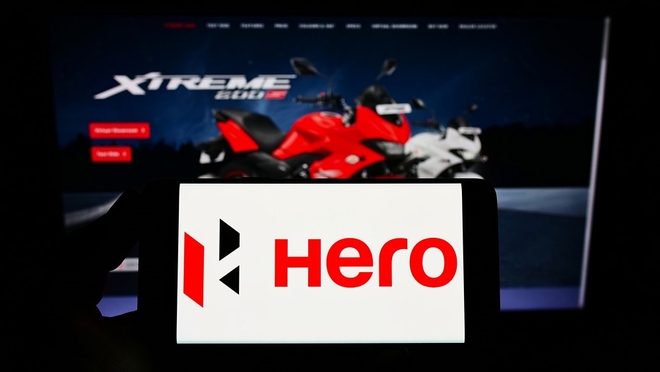
Hero is a name synonymous with two-wheeler vehicles in India. Starting as a cycle seller in 1956, Hero MotoCorp became the largest motorbike manufacturer in the country, partly due to the iconic 'Splendor'. A household name, the company has so far sold over 10 crore units in its lifetime. Impressively, at its peak, the company had cornered 41 per cent market share.

However, Hero's halo has dulled in recent years. The company has not only experienced a decline in volumes of about 2 per cent over the past decade but also seen its market share drop to 33 per cent in FY23.
This downturn affects Hero MotoCorp's competitive standing in the industry and is also reflected in its financial performance. Currently, the company ranks at the bottom among its peers in terms of market cap.
Financial race
Comparing Hero MotoCorp's performance with peers
| Company | Market cap (Rs cr) | 10Y revenue growth (% pa) | 10Y PAT growth (% pa) | 10Y median ROCE (%) | FY23 ROCE (%) |
|---|---|---|---|---|---|
| Bajaj Auto | 200,580 | 6.1 | 6.5 | 31.3 | 26.5 |
| Eicher Motors | 101,020 | 7.8 | 18.7 | 37.6 | 27.5 |
| TVS Motor | 95,564 | 14.3 | 21.5 | 17.6 | 14.1 |
| Hero MotoCorp | 87,855 | 3.1 | 2.9 | 43.4 | 23.9 |
| Market cap as of January 18, 2024. Financials as of FY23. | |||||

So, what happened with the company? Let's try to decipher.
The depressing breakup
A pivotal moment in Hero's history was the joint venture with Honda in 1984. Under this partnership, Honda focused on research and development (R&D), while Hero focused on scaling up its manufacturing. This successful joint venture helped 'Hero Honda' become the largest player in the two-wheeler segment.
However, this partnership ended in 2011. Post-split, while Hero aimed to expand its presence by venturing into export markets (which was not part of the original agreement with Honda), it lost a vital R&D partner. On the other hand, Honda went on to develop manufacturing facilities and distribution systems to expand operations under its own brand in India.
The period following the split saw Hero MotoCorp struggling to maintain its dominant position.
The rise of scooters (or scooty)
The early 2010s saw the rise of new-age scooters in India. Leading the race was Hero's former partner, Honda. These scooters were priced similarly to Hero's mass-market vehicles and were easier to operate than motorcycles. This was a huge selling point for scooters. Honda's 'Activa' has become the best-selling scooter in India, recording three crore sales since 2001.
Hero suffered a major blow as mass-market motorcycles played a significant part in its portfolio compared to its competitors. While it did launch multiple scooter models, it couldn't succeed. The reason? Not enough R&D. It established its first R&D centre almost four years after the split with Honda. Its spending on R&D was minimal, too, compared to its competitors, Bajaj Auto and TVS Motors .
Struggling with premiumisation
The latter half of the last decade witnessed premium two-wheelers come into vogue. This segment achieved a remarkable growth of 72 per cent in the past four years.

And again, Hero's attempts to capture this market were largely unsuccessful. It held a mere 3 per cent market share based on volumes as of 2023. While it launched multiple models in recent years in the 125cc+ category, several failed. In fact, in 2017, the company had to discontinue seven of its motorcycles due to poor sales.

Despite consistently investing a significant part of its revenue (around 2 per cent) in marketing, Hero MotoCorp has been unable to increase its market share in the premium segment. It is losing customers to other two-wheeler competitors such as Royal Enfield ( Eicher ), TVS, and Suzuki. The decline can be witnessed especially in the last three years when premium motorcycles were riding high.
These failed attempts have forced the company to focus on increasing its market share in the mass-market segment in the last few years. Meanwhile, this entire segment has been falling, making Hero a losing bet in the race.
Lagging on the electric side
Hero MotoCorp also ventured into the electric vehicle (EV) space. The company launched its sub-brand, 'Vida,' which is dedicated to EV scooters. However, its first-ever EV scooter, 'Vida V1', received poor reception because it was sold at a higher price. The volumes were below average, with just 3,286 units sold in November 2023 (according to RushLane, an auto news website).
To top it off, it entered when the segment was already crowded with established players like Ola Electric and Okinawa, who were selling more than 1,50,000 and 90,000 units in the same period, respectively.
The road ahead
Despite the challenges faced in the last decade, Hero is continuing its attempts to establish itself in the premium and electric vehicle segment.
It has collaborated with Harley Davidson to manufacture and sell motorcycles under the latter's brand name. It has also acquired a 39.7 per cent stake in Ather (an electric two-wheeler manufacturer), the third largest EV player holding an 11 per cent market share in the nine months ending December 2023 period.
However, one can't deny the competition in all segments. Whether Hero MotoCorp will be able to adapt to the evolving two-wheeler segment is something only time will tell. In the auto industry, one good launch can change a company's fortunes, and Hero has been eagerly waiting for such a launch for many years.
Also read: Bajaj Auto announced Rs 4,000 crore buyback








